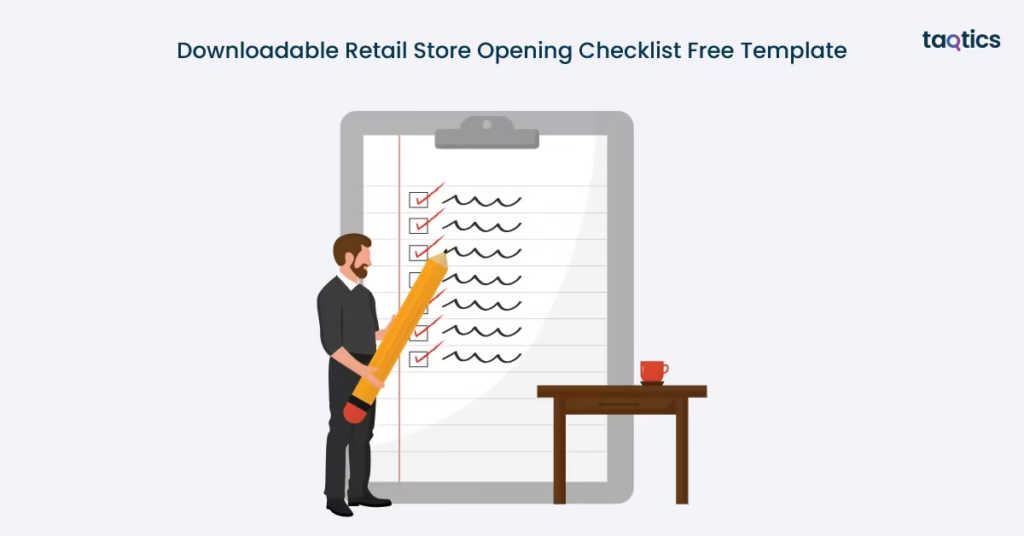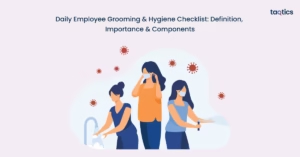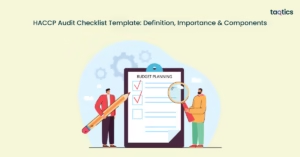Retail Store Opening Checklist: Benefits, What Should Include, Free Template

Retail store opening checklist allows a retail store in India to open with careful planning and flawless execution, especially in today’s competitive retail landscape, where the US retail sales are projected to reach nearly $7.9 trillion by 2026. A well-structured retail store opening checklist is essential for ensuring operational efficiency, safety, and a consistently positive customer experience from the moment doors open each day.
A comprehensive checklist not only streamlines daily routines and reduces the risk of overlooked tasks, but also delivers measurable benefits. For instance, it enhances security and helps maintain compliance to avoid costly fines, and improves staff communication and accountability. Moreover, checklists have been shown in studies to significantly reduce mistakes and improve outcomes in high-stakes environments, a principle that translates directly to retail operations.
What Is A Retail Store Opening Checklist?
A retail store opening checklist is a detailed, step-by-step list of tasks that employees must complete each morning to prepare the store for customers and ensure smooth daily operations. It serves as a practical tool to organize and standardize opening procedures, covering everything from security checks and electronics setup to housekeeping, merchandising, and staff readiness.
For example, a typical retail store opening checklist might start with a security inspection, checking for broken windows, signs of break-ins, or suspicious activity around the store before unlocking the doors. Next, employees would turn off the security alarm, unlock the doors to let staff in, and verify that surveillance cameras and alarms are functioning properly. Then, the checklist would include turning on the Point of Sale (POS) system and related electronics, ensuring cash drawers are stocked with the correct float, and testing payment equipment.
Why You Need a Retail Store Opening Checklist
You need a retail store opening checklist for reasons contributing to the overall efficiency, customer experience, and success of the business.
- Enhances store readiness and brand standards: A detailed checklist ensures that every aspect of the store meets the brand’s standards before customers enter. This includes setting up appealing window displays, organizing product placements, and ensuring the storefront is inviting, which collectively boosts foot traffic and sales opportunities. By adhering to a structured approach, retailers maintain consistency across all locations, reinforcing brand identity and maximizing the impact of promotional campaigns.
- Helps reduce human error and oversight: Checklists minimize the risk of overlooking critical tasks, ensuring that essential procedures are consistently followed. For example, security protocols such as checking for signs of break-ins, ensuring the alarm system is working, and verifying surveillance cameras are operational are less likely to be missed. Similarly, inventory checks, including restocking shelves and managing promotional materials, prevent stockouts and ensure a seamless shopping experience.
- Keeps staff aligned on responsibilities: By clearly outlining tasks and assigning roles, a checklist ensures that all team members are aware of their responsibilities and daily goals. This improves communication and coordination among staff, allowing them to focus on their duties, whether it’s opening or closing the store. A quick team meeting to review daily priorities, promotions, and any operational updates further aligns the staff, setting a positive tone for the day.
- Ideal for both daily procedures and grand openings: While essential for daily operations, a retail store opening checklist is equally valuable for grand openings, where attention to detail is critical to making a positive first impression. The checklist can be adapted to include additional tasks specific to the event, such as setting up special displays, ensuring adequate staffing, and managing promotional activities. This adaptability ensures that whether it’s a regular day or a special event, the store is always ready to provide an exceptional customer experience.
Now that the reasons are known, let us explore on the benefits of the retail store opening checklist.
Benefits of Using a Retail Store Opening Checklist
A retail store opening checklist is vital for several reasons, each contributing to the overall efficiency, customer experience, and success of the business.
- Improves Safety and Security: Retail theft in the U.S. caused losses of $94.5 billion in 2021, highlighting the importance of strict security protocols. A checklist ensures that essential security tasks, such as inspecting the premises for signs of break-ins, properly setting alarms, and securing high-value items, are consistently completed, protecting both employees and inventory.
- Saves Money by Ensuring Compliance: Retail stores face fines for regulatory violations, like a $500 penalty in New York City for not displaying a refund policy. A checklist helps ensure compliance with local laws and industry regulations, preventing costly fines and safeguarding the store’s reputation.
- Streamlines Customer Service: By standardizing opening procedures, a checklist helps staff deliver consistent, high-quality customer service. Employees stay informed about ongoing promotions, are prepared to handle customer inquiries, and maintain a clean, welcoming environment, which leads to better customer satisfaction and loyalty.
- Enhances Communication and Staff Coordination: A checklist clarifies daily responsibilities and encourages communication between managers and staff. It supports team meetings to review goals and operational updates, helping employees stay aligned and focused on their tasks, which improves overall efficiency.
- Ensures Operational Consistency and Readiness: From inventory checks and merchandising to housekeeping and equipment setup, a checklist guarantees that the store is fully prepared before opening. This reduces errors, prevents last-minute rushes, and maintains brand standards across all locations.
- Adapts to Seasonal and Event Needs: Checklists can be tailored for special occasions like grand openings or seasonal changes, ensuring that additional tasks, such as setting up promotional displays or managing increased foot traffic, are not overlooked
The next section is dedicated to the elements to be included in the retail store opening checklist.
What Should a Retail Store Opening Checklist Include?
There are eight things that a retail store opening checklist must include.

Security
A crucial component of a retail store opening checklist is the security section, which ensures the safety of the store, employees, and customers from the moment the store opens.
- Checking alarm systems to confirm they are functioning correctly, which helps prevent unauthorized access and alerts staff to any security breaches.
- Testing CCTV cameras is equally important to verify that surveillance coverage is active and recording, providing both a deterrent to theft and evidence if incidents occur.
- Confirming that all door locks and emergency exits are secure and operational guarantees controlled access and safe evacuation routes in case of emergencies.
- Reviewing access control procedures, such as who has keys or security codes and how staff enter the premises, helps maintain strict control over store entry and reduces the risk of internal or external security threats.
These tasks form a foundational security protocol that protects the store’s assets and personnel, making them essential items on any retail store opening checklist.
Housekeeping
Housekeeping is a crucial component of a retail store opening checklist, ensuring the environment is clean, safe, and welcoming for both customers and staff.
- Thoroughly cleaning the sales floor and backroom by sweeping, mopping, dusting, and organizing to maintain a tidy and professional appearance.
- estroom readiness is essential, requiring daily cleaning, restocking of supplies, and disinfection of all surfaces to prevent the spread of germs and provide a positive customer experience.
- Regular trash removal from all areas of the store, including sales floor, backroom, and restrooms, helps maintain cleanliness and prevents unpleasant odors.
- In the post-COVID era, strict sanitization protocols have become even more important, with frequent disinfection of high-touch surfaces, installation of hand sanitizing stations, and adherence to hygiene guidelines to protect the health of both shoppers and employees.
By including these housekeeping tasks in the opening checklist, retail stores create a safe and inviting atmosphere that supports customer confidence and smooth daily operations
Electronics
The electronics section involves powering on all essential systems to ensure smooth daily operations.
- Turning on the Point of Sale (POS) system, computers, tablets, and any other electronic devices used for sales and inventory management.
- Checking that lighting and HVAC systems are functioning properly to create a comfortable and well-lit shopping environment.
- Testing the Wi-Fi and internet connectivity is crucial for seamless transaction processing and customer service, especially as many stores rely on cloud-based systems and digital payment methods.
- Inspecting all electrical outlets and display electronics, such as digital signs and product displays, to confirm they are working correctly and safely.
This comprehensive electronics check helps prevent technical issues during business hours and supports a professional customer experience.
POS/Cash Registers
Preparing the POS (Point of Sale) and cash registers is essential to ensure smooth and efficient transactions throughout the day.
- Boot up all POS terminals and logging into the system to confirm it is operational.
- Load receipt printers with paper, and stock cash drawers with the appropriate starting cash float, including enough small bills and coins to provide change for customers.
- Test barcode scanners to verify they accurately read product codes, preventing delays at checkout.
- Run test transactions helps confirm that the entire system, from scanning items to processing payments and printing receipts, is functioning correctly.
These steps minimize the risk of technical issues during business hours, support accurate sales tracking, and enhance the customer experience.
Merchandising
Merchandising creates an appealing and customer-friendly shopping environment.
- Carefully checking all displays and product placements to ensure they align with the store’s visual merchandising standards and promotional strategies.
- Tidy shelves by straightening products, removing any clutter, and organizing featured items to highlight key offerings and promotions.
- Refilling promotional zones is essential to maintain the visibility and availability of advertised products, preventing stockouts and maximizing sales opportunities.
By completing these merchandising tasks, retail stores can enhance the overall shopping experience, attract customers, and effectively promote their products.
Inventory
Inventory management is a vital task that ensures product availability and accuracy before customers arrive.
- Perform a stock count to verify that the physical inventory matches the records and the planned sales floor layout.
- Restock shelves as needed keeps the store well-prepared to meet customer demand and prevents empty displays that could negatively impact sales.
- Check for damaged goods is also crucial to maintain product quality and customer satisfaction by removing or replacing any defective items.
- Match the stock with the sales floor plan guarantees that products are correctly placed according to merchandising strategies and promotional priorities, supporting an organized and efficient shopping experience.
These inventory checks help maintain operational readiness and contribute to smooth daily store functioning.
Signage and Tags
Verifying signage and tags is essential to ensure clear communication and a professional appearance that aligns with brand standards.
- Check that all price tags and promotional signage are accurate, legible, and correctly placed to avoid customer confusion and support sales efforts.
- Digital signage and screens should also be inspected to confirm they are functioning properly and displaying the intended content.
- Ensure all signage complies with the store’s brand guidelines helps maintain a consistent look and feel, reinforcing brand identity and customer trust.
Properly managed signage and tags contribute to a seamless shopping experience and effective promotion of products and offers.
Staff
Managing staff effectively is critical to ensuring a smooth and organized start to the day.
- Confirming attendance and clearly defining each team member’s roles to guarantee that all necessary positions are covered.
- Conducting a pre-opening team huddle provides an opportunity to communicate daily goals, share important updates, and motivate the staff for the day ahead.
- Assigning specific duties and service areas helps streamline workflow and ensures that every part of the store receives proper attention, from customer service to merchandising.
- Checking uniforms and grooming standards reinforces a professional appearance that reflects the store’s brand image and creates a positive impression on customers.
Together, these steps foster a cohesive, prepared, and customer-focused team ready to deliver excellent service.
Digitize Your Retail Store Opening Checklist Using Taqtics
You can digitize your retail store opening checklist using Taqtics. Taqtics is a comprehensive retail execution platform designed to digitize and streamline store operations, making retail store opening checklists more efficient and manageable. By using Taqtics, retailers gain real-time task tracking, allowing managers and teams to monitor checklist progress instantly and address issues promptly.
Benefits of Using Taqtics:
- Real-time Task Tracking: Monitor checklist progress instantly to quickly identify and resolve issues.
- Cloud-Based Checklist Templates: Customize and schedule digital checklists accessible from anywhere, eliminating paper forms.
- Multi-Location Scalability: Manage and oversee operations across multiple store locations from a centralized dashboard.
- Photo Proof and Digital Audit Trails: Capture visual evidence and timestamps for completed tasks, enhancing transparency and accountability.
- Automated Reporting and Follow-ups: Generate instant reports and automate corrective actions to improve operational efficiency.
This digital approach helps retailers maintain compliance, improve productivity, and ensure smooth store openings every day. Taqtics is available via mobile apps and web browsers for convenient, on-the-go use.
Explore detailed features and sign up at Taqtics official website.
Best Practices for Store Opening Checklist Implementation
The best practices for store opening checklist implementation include everything from assigning ownershi to automating reminders.
- Assign Ownership: Designate specific team members responsible for each task to ensure accountability and prevent tasks from being overlooked.
- Schedule Regular Training: Conduct ongoing training sessions to keep staff updated on checklist procedures, reinforce standards, and address any operational changes.
- Audit Checklist Completion: Regularly review and verify that all tasks are completed accurately and on time to identify areas for improvement.
- Continuously Update Checklist: Adapt and refine the checklist based on store performance, feedback, and changing operational needs to maintain relevance.
- Use Mobile Access: Enable staff to complete and review checklist tasks via smartphones or tablets for increased convenience and efficiency.
- Automate Reminders and Updates: Implement automated daily reminders and notifications to keep the team informed, focused, and compliant with checklist requirements.
These practices help ensure consistent, efficient, and effective store opening operations.
Why is a checklist important in retail?
A checklist is important in retail for below-mentioned reasons.
- Ensures Task Accuracy and Consistency: Checklists help store managers and employees follow standardized procedures, reducing errors and ensuring consistent performance across all tasks.
- Reduces Errors and Omissions: By listing all necessary steps, checklists minimize the risk of missing critical tasks, which can prevent costly mistakes and operational failures.
- Improves Efficiency and Time Management: Checklists allow better allocation of time and effort by prioritizing vital tasks, leading to smoother store operations and increased productivity.
- Enhances Customer Experience: A well-executed checklist ensures the store is clean, stocked, and visually appealing, which boosts customer satisfaction and encourages repeat visits.
- Supports Compliance and Safety: Retail checklists help maintain safety protocols, regulatory compliance, and security measures, protecting both employees and customers while avoiding fines.
- Facilitates Communication and Accountability: Checklists clarify employee responsibilities, reduce confusion, and improve communication between staff and management.
- Enables Data-Driven Improvements: Regular use of checklists during store visits and audits provides structured feedback, helping identify performance gaps and opportunities for continuous improvement.
- Boosts Sales and Store Performance: Consistent implementation of checklists has been linked to increased sales, better inventory management, and overall store effectiveness.
Retail checklists are vital tools that streamline operations, enhance safety and compliance, improve customer experience, and drive business success.
What is the difference between a soft opening and a grand opening?
The difference between a soft opening and a grand opening has been provided in the tabular format below:
| Aspect | Soft Opening | Grand Opening |
| Purpose | Test operations, gather feedback, and refine processes before official launch. | Create buzz, attract customers, and officially announce store opening to the public. |
| Audience | Invitation-only or limited to friends, family, local press, and business owners. | Open to the general public and broader community. |
| Focus | Operational readiness, staff training, and identifying issues. | Marketing, customer engagement, and brand presence. |
| Duration | Can last several days to weeks, depending on feedback and improvements needed. | Typically a one-day to one-week event designed to maximize attendance and excitement. |
| Scale | Smaller, quieter, and controlled environment. | Larger, festive, and highly publicized event with promotions and giveaways. |
| Marketing | Limited or targeted invitations, minimal advertising. | Extensive marketing through social media, flyers, local ads, and press releases. |
| Operational Impact | Allows staff to practice and smooth out processes without pressure of large crowds. | Staff focus shifts to customer interaction and event management rather than operational testing. |
While a soft opening serves as a rehearsal focused on operational testing and feedback with a limited audience, a grand opening is a celebratory, public event aimed at generating excitement and attracting customers.



